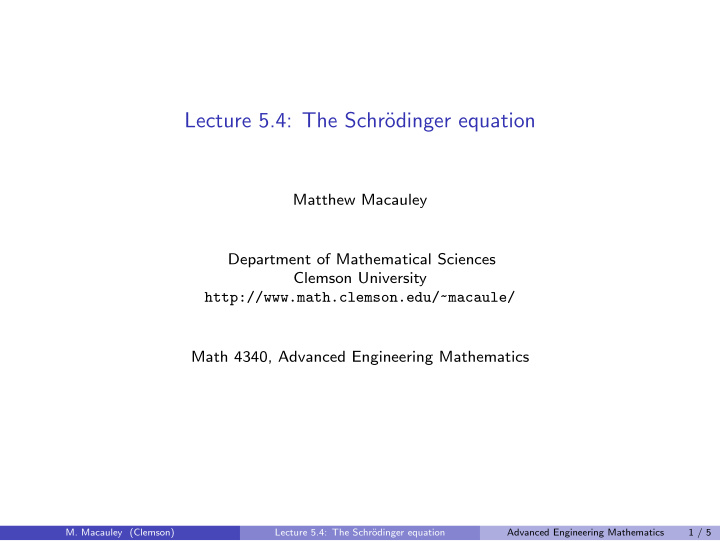



Lecture 5.4: The Schr¨ odinger equation Matthew Macauley Department of Mathematical Sciences Clemson University http://www.math.clemson.edu/~macaule/ Math 4340, Advanced Engineering Mathematics M. Macauley (Clemson) Lecture 5.4: The Schr¨ odinger equation Advanced Engineering Mathematics 1 / 5
Some history Newton’s second law of motion, mx ′′ ( t ) = F ( x ), fails on the atomic scale. According to quantum mechanics, particles have no definite position or velocity. Instead, their states are described probabilistically by a wave function Ψ( x , t ), where ˆ b | Ψ( x , t ) | 2 dx = Probability of the particle being in [ a , b ] at time t . a Motivation The wave function is governed by the following PDE, called Schr¨ odinger’s equation: i � Ψ t = − � 2 2 m Ψ xx + V ( x )Ψ , 2 π , where h ≈ 6 . 625 · 10 − 34 kg m 2 /s is h where V ( x ) = potential energy, m = mass, and � = Planck’s constant. The linear operator H = − � 2 ∂ 2 ∂ x 2 + V ( x ) is the Hamiltonian. 2 m The special case of V = 0 (free particle subject to no forces) is the free Schr¨ odinger equation i � Ψ t = − � 2 2 m Ψ xx . M. Macauley (Clemson) Lecture 5.4: The Schr¨ odinger equation Advanced Engineering Mathematics 2 / 5
Solving the Schr¨ odinger equation To solve i � Ψ t = H Ψ, i.e., i � Ψ t = − � 2 2 m Ψ xx + V ( x )Ψ , assume that Ψ( x , t ) = f ( x ) g ( t ). M. Macauley (Clemson) Lecture 5.4: The Schr¨ odinger equation Advanced Engineering Mathematics 3 / 5
The infinite potential well Example The wave function of a free particle of mass m confined to 0 < x < L is described by the boundary value problem i � Ψ t = − � 2 2 m Ψ xx , Ψ(0 , t ) = Ψ( L , t ) = 0 . M. Macauley (Clemson) Lecture 5.4: The Schr¨ odinger equation Advanced Engineering Mathematics 4 / 5
Summary Consider the Schr¨ odinger equation on a bounded domain, i � Ψ t = − � 2 2 m Ψ xx + V ( x )Ψ , 0 < x < L . For each n = 1 , 2 , . . . , we have a solution of the form E n = � 2 π 2 n 2 Ψ n ( x , t ) = f n ( x ) e − iE n t / � , 2 mL 2 where f n ( x ) solves the time-independent Schr¨ odinger equation − � 2 f ′′ n + V ( x ) = E . 2 m f n The solution is the superposition and time-evolution given by ˆ L ∞ | Ψ( x , t ) | 2 dx = 1 . � f n ( x ) e − iE n t / � , Ψ( x , t ) = and 0 n =1 In the special case of the free Schr¨ odinger equation ( V ( x ) = 0) and the infinite potential well, this becomes ∞ � � n π x e − iE n t / � . Ψ( x , t ) = b n sin � L n =1 M. Macauley (Clemson) Lecture 5.4: The Schr¨ odinger equation Advanced Engineering Mathematics 5 / 5
Recommend
More recommend